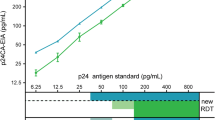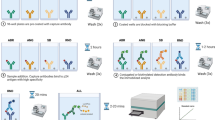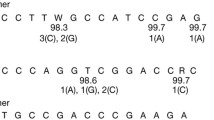Abstract
The presence of p24 core antigen in the serum of individuals with human acquired immunodeficiency syndrome has been used as one of the important prognostic markers of HIV-1 infection and also as an end point in evaluating antiviral drugs and vaccines. Unfortunately the majority of p24 antigen present in serum exists as an antigenantibody complex and is not detected with the commercial kits currently available to measure p24 antigen. In this study, we report a simple procedure utilizing treatment of serum samples with glycine buffer (pH 1.85) to dissociate antigen-antibody complexes prior to assaying for p24 antigen. A 300% increase in the number of p24-reactive samples and a 3- to 12-fold increase in the quantity of antigen detected were observed when samples were pretreated with 1.5M glycine buffer (pH 1.85) for 1 hr. Glycine treatment of samples did not result in nonspecific positive tests and samples previously shown to be reactive remained positive. In reconstruction experiments the release of antigen was found to be inversely proportional to the amount of p24 antibody present in the serum. The percentage of HIV-1-infected patients positive for p24 antigen was clearly a function of CD4 count. Forty-nine percent of patients with more than 500 CD4 cells and 100% of patients with less than 200 CD4 were p24 positive. The improved sensitivity for detection of p24 provided by this procedure enhances our understanding of the pathogenesis of AIDS by showing that the majority of patients with HIV-1 infection is p24 positive and facilitates the analysis of data obtained in clinical trials involving anti-HIV compounds.
Similar content being viewed by others
References
Lange JMA, de Wolf F, Goudsmit J: Markers for progression in HIV infection. AIDS 3:S153-S160, 1989
Moss AR, Bacchett P, Osmond D, Krampf W, Chaisson RE, Stites D, Wilber J, Allain JP, Carlson J: Seropositivity for HIV and the development of AIDS or AIDS related condition: Three year follow up of the San Francisco General Hospital cohort. Br Med J 296:745–750, 1988
van Griensven GJP, de Vroome EMM, de Wolf F, Goudsmit J, Roos M, Coutinho RA: Risk factors for progression of human immunodeficiency virus (HIV) infection among seroconverted and seropositive homosexual men. Am J Epidemiol 132:203–210, 1990
Fischl MA, Richman DD, Grieco MH, AZT Collaborative Working Group: The efficacy of azidothymidine (AZT) in the treatment of patients with AIDS and AIDS-related complex. A double-blind, placebo-controlled trial. N Engl J Med 317:185–191, 1987
Spector SA, Kennedy C, McCutchan JA, Bozzette SA, Straube RG, Connor JD, Richman DD: The antiviral effect of zidovudine and ribavirin in clinical trials and the use of p24 antigen levels as a virologic marker. J Infect Dis 159:822–828, 1989
Yarchoan R, Broder S: Development of antiretroviral therapy for the acquired immunodeficiency syndrome and related disorders. N Engl J Med 316:557–564, 1987
Bowen DL, Lane HC, Fauci AS: Immunopathogenesis of the acquired immunodeficiency syndrome. Ann Intern Med 103:704–709, 1985
de Wolf F, Lange JMA, Houweling JTM, Coutinho RA, Schellekens PT, Van der Noordaa J, Goudsmit J: Numbers of CD4+ cells and the levels of core antigens of and antibodies to the human immunodeficiency virus as predictors of AIDS among seropositive homosexual men. J Infect Dis 158:615–622, 1988
Phillips A, Lee CA, Elford J, Janossy G, Timms A, Bofill M, Kernoff PB: Serial CD4 lymphocyte counts and development of AIDS. Lancet 337:389–392, 1991
Paul DA, Falk LA, Kessler HA, Chase RM, Blaauw B, Chudwin DS, Landay AL: Correlation of serum HIV antigen and antibody with clinical status in HIV-infected patients. J Med Virol 22:357–363, 1987
Sei Y, Tsang PH, Chu FN, Wallace I, Roboz JP, Sarin PS, Bekesi JG: Inverse relationship between HIV-1 p24 antigenemia, anti-p24 antibody and neutralizing antibody response in all stage of HIV-1 infection. Immunol Lett 20:223–230, 1989
Murray HW, Godbold JH, Jurica KB, Roberts RB: Progression to AIDS in patients with lymphadenopathy or AIDS-related complex: Reappraisal of risk and predictive factors. Am J Med 86:533–538, 1989
Gains H, Albert J, von Sydow M, Sonnerberg A, Chiodi F, Ehrnst A, Strannegard O, Asjo B: HIV antigenemia and virus isolation from plasma during primary HIV infection. Lancet i:1317–1318, 1987
Lange JMA, Paul DA, de Wolf F, Coutinho RA, Goudsmit J: Viral gene expression, antibody production, and immune complex formation in human immunodeficiency virus infection. AIDS 1:15–20, 1987
McDougal JS, Cort SP, Kennedy MS: Immunoassay for the detection and quantitation of infectious human retrovirus, lymphadenopathy-associated virus (LAV). J Immunol Methods 76:171–183, 1985
Tsiquaye KN, Youle M, Chanas AC: Restriction of sensitivity of HIV-1 antigen ELISA by serum anti-core antibodies. AIDS 2:41–45, 1988
Wittek AE, Phelan MA, Wells MA, Vujcic LK, Epstein JS, Lane HC, Quinnan GV Jr: Detection of human immunodeficiency virus core protein in plasma by enzyme immunoassay. Association of antigenemia with symptomatic disease and T-helper cell depletion. Ann Intern Med 107:286–292, 1987
Nishanian P, Huskins KR, Stehn S, Detels R, Fahey JL: A simple method for improved assay demonstrates that HIV p24 antigen is present as immune complexes in most sera from HIV-infected individuals. J Infect Dis 162:21–28, 1990
von Sydow M, Gaines H, Sonnerborg A, Forsgren M, Pehrson PO, Strannegard O: Antigen detection in primary HIV infection. Br Med J 296:238–240, 1988
Kageyama S, Yamada O, Mohammad SS, Hama S, Hattori N, Asanaka M, Nakayama E, Matsumoto T, Higuchi F, Kawatani T: An improved method for the detection of HIV antigen in the blood of carriers. J Virol Methods 22:125–131, 1988
Kesten L, Hoffd G, Gigas PL, Deley R, van der Groen G: HIV antigen detection in circulating immune complexes. J Virol Methods 31:67–76, 1991
Folks TM, Powell D, Lightfoote M, Koenig S, Fauci AS, Benn S, Rabson A, Daugherty D, Gendelman, Hogan MD, Venkatesan S, Martin MA: Biological and biochemical characterization of a cloned Leu-3+ cell surviving infection with the acquired immune deficiency syndrome retrovirus. J Exp Med 164:280–290, 1986
Schnittman SM, Psallidopoulos MC, Lane HC, Thompson L, Baseler M, Massari F, Fox CH, Salzman NP, Fauci AS: The reservoir for HIV-1 in human peripheral blood is a T cell that maintains expression of CD4. Science 245:305–308, 1989
Author information
Authors and Affiliations
Rights and permissions
About this article
Cite this article
Vasudevachari, M.B., Salzman, N.P., Woll, D.R. et al. Clinical utility of an enhanced human immunodeficiency virus type 1 p24 antigen capture assay. J Clin Immunol 13, 185–192 (1993). https://doi.org/10.1007/BF00919971
Accepted:
Issue Date:
DOI: https://doi.org/10.1007/BF00919971




